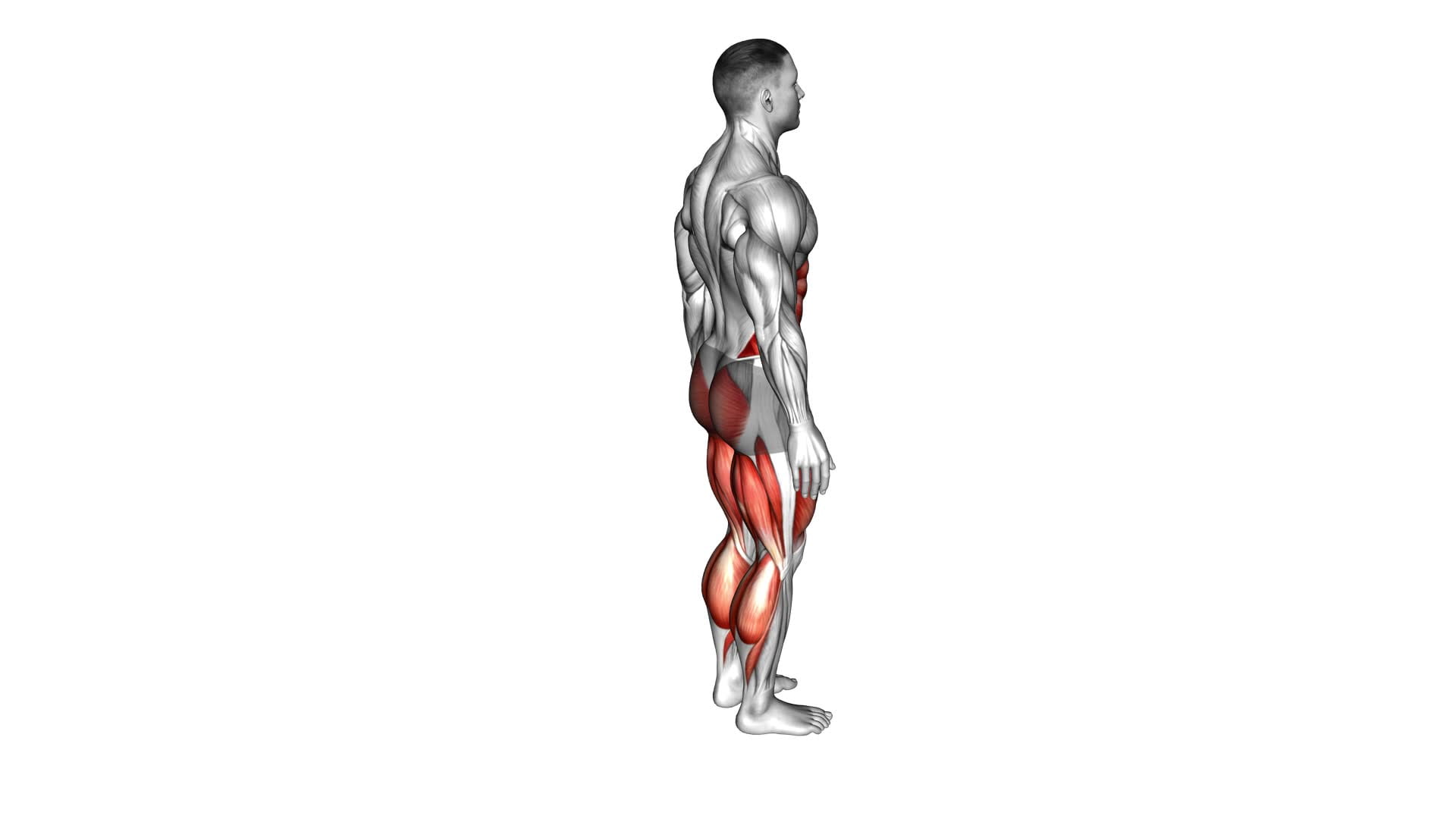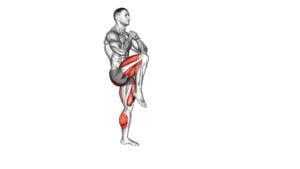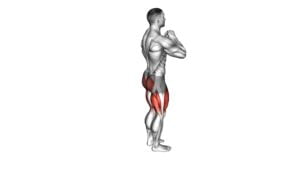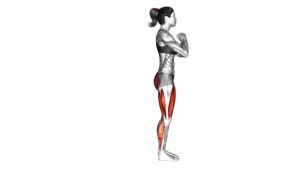Reverse Lunge Knee Drive (male) – Video Exercise Guide & Tips

Are you looking to strengthen your legs and improve your overall fitness? Look no further than the reverse lunge knee drive! This exercise targets your glutes, quads, and hamstrings while also engaging your core.
Watch This Exercise Video
In this video exercise guide, we'll show you the proper form to ensure maximum effectiveness and help you avoid common mistakes. Whether you're a beginner or an experienced exerciser, our tips will help you get the most out of your reverse lunge knee drives.
Let's get started!
Key Takeaways
- The reverse lunge knee drive targets multiple muscle groups including the glutes, quads, hamstrings, and core.
- It helps increase lower body strength and power, as well as improve balance and stability.
- Engaging in this exercise provides a full-body workout and can help develop explosive power.
- It is important to maintain proper form and technique, avoiding common mistakes such as not engaging the core, rushing through the exercise, and allowing the knee to cave inwards.
Benefits of Reverse Lunge Knee Drive
The reverse lunge knee drive offers a variety of benefits for individuals seeking to improve lower body strength and stability. This exercise primarily targets the quadriceps, hamstrings, glutes, and calves. By performing the reverse lunge knee drive, you engage these muscles, leading to increased strength and power in your lower body.
To incorporate the reverse lunge knee drive into your workout routine, start by standing with your feet hip-width apart. Take a step back with your right leg, lowering your body into a lunge position. As you lower, drive your left knee up towards your chest, engaging your core. Return to the starting position and repeat on the other side.
To add intensity to this exercise, you can hold dumbbells in each hand or use a resistance band around your thighs. You can also increase the difficulty by performing the exercise on an unstable surface, such as a Bosu ball.
Including the reverse lunge knee drive in your workout routine can help improve balance, stability, and overall lower body strength. It's a versatile exercise that can be modified to suit your fitness level and goals.
Proper Form for Reverse Lunge Knee Drive
To perform the reverse lunge knee drive with proper form, start by standing with your feet hip-width apart. Take a step back with your right foot, keeping your weight on the ball of your left foot. Bend both knees to lower your body down into a lunge position, ensuring that your left knee doesn't extend beyond your toes. Engage your core and keep your torso upright throughout the movement.
As you push through your left heel to return to the starting position, drive your right knee up towards your chest. Use your core muscles to control the movement and maintain balance. Keep your chest lifted and your shoulders relaxed.
Proper technique is crucial to get the most out of this exercise and prevent injury. One common error is leaning forward, which places excessive strain on your knees and lower back. Remember to keep your upper body upright and avoid rounding your shoulders.
Another mistake to avoid is allowing your knee to cave inwards during the knee drive. This can strain the knee joint and compromise stability. Focus on driving your knee straight up and maintaining proper alignment.
Common Mistakes to Avoid
Avoid these common mistakes when performing the reverse lunge knee drive exercise to ensure proper technique and maximize your results.
One common mistake isn't maintaining proper alignment during the exercise. It's important to keep your front knee directly over your ankle and not let it go past your toes. This helps protect your knee and ensures that you're engaging the correct muscles.
Another mistake isn't engaging your core throughout the movement. Your core muscles help stabilize your body and maintain balance, so make sure to keep them activated during the exercise.
Another common mistake is rushing through the exercise and not maintaining control. It's important to perform the movement slowly and with control, focusing on each step and making sure to engage the correct muscles. This will help you get the most out of the exercise and reduce the risk of injury.
Lastly, be mindful of your balance during the exercise. It's common to lose balance and stability when performing the reverse lunge knee drive. To avoid this, make sure to keep your weight centered and evenly distributed between your front and back leg. This will help you stay stable and perform the exercise with proper form.
Variations and Modifications
To maximize your workout and target different muscle groups, you can explore various variations and modifications of the reverse lunge knee drive exercise. Here are four options to consider:
- Dumbbell Reverse Lunge Knee Drive: Hold a dumbbell in each hand while performing the exercise. This adds resistance, increasing the challenge and helping to build strength in your lower body.
- Front Rack Reverse Lunge Knee Drive: Instead of holding the dumbbells by your sides, bring them up to your shoulders, resting them on your collarbone. This variation engages your core and upper body, providing a full-body workout.
- Split Squat Knee Drive: Instead of stepping back into a reverse lunge, keep your feet parallel and perform a split squat. This modification allows for greater stability and can be beneficial if you have knee or balance issues.
- Plyometric Reverse Lunge Knee Drive: Add an explosive jump between each rep. This variation increases the intensity, helping to improve power and agility.
Incorporating variations and modifications into your reverse lunge knee drive routine can offer several advantages. They can help prevent workout plateaus by challenging your muscles in new ways. Additionally, adaptations can target specific muscle groups, allowing you to focus on areas that need strengthening or development.
Experiment with these variations to keep your workouts fresh and continue making progress towards your fitness goals.
Tips for Maximizing Results
To maximize your results, consistently incorporate the reverse lunge knee drive exercise into your fitness routine. This exercise targets multiple muscle groups, including the glutes, quads, and core, making it an effective way to build strength and improve overall fitness.
However, to truly maximize your results, it's important to also focus on nutrition and recovery strategies.
When it comes to nutrition, fueling your body with the right nutrients is crucial for optimizing performance and enhancing results. Aim to consume a well-balanced diet that includes lean proteins, complex carbohydrates, and healthy fats. These nutrients will provide your body with the necessary fuel and building blocks for muscle growth and repair.
In addition to proper nutrition, recovery strategies play a key role in maximizing your results. Give your body enough time to rest and recover between workouts to prevent overtraining and reduce the risk of injury. Incorporate activities such as stretching, foam rolling, and massage to help relax and release tight muscles. Adequate sleep is also essential for recovery, as it allows your body to repair and regenerate.
Frequently Asked Questions
How Many Calories Does the Reverse Lunge Knee Drive Exercise Burn?
The reverse lunge knee drive exercise is a great way to burn calories and work your lower body. It targets your quads, glutes, and hamstrings while also engaging your core.
There are a few variations of this exercise, such as adding weights or incorporating a twist.
In terms of calorie burn, the reverse lunge knee drive is an effective option, but it may not burn as many calories as some other lower body exercises like squats or lunges.
Can Reverse Lunge Knee Drive Help Improve Balance and Stability?
Adding reverse lunge knee drive variations to your workout routine can definitely help improve your balance and stability.
By performing this exercise, you engage multiple muscles in your legs, including your glutes, quadriceps, and hamstrings, which all play a crucial role in maintaining balance.
Additionally, the knee drive movement requires core stability and control, further enhancing your overall balance and stability.
Incorporating reverse lunge knee drive into your workouts can provide great benefits for your fitness goals.
Is Reverse Lunge Knee Drive Suitable for Beginners?
Reverse lunge knee drive can be suitable for beginners with some modifications. Start by performing the exercise without weights to focus on form and stability. Take smaller steps to reduce the difficulty.
Avoid common mistakes like letting your knee go past your toes or leaning forward excessively. Engage your core and maintain a straight posture throughout the movement.
As you progress, you can gradually increase the intensity by adding weights or increasing the range of motion.
Can Reverse Lunge Knee Drive Help Strengthen the Core Muscles?
Yes, incorporating reverse lunge knee drive variations into your workout routine can help strengthen your core muscles. This exercise targets not only your lower body but also engages your abs and back muscles for stability and balance.
By adding a knee drive at the end of the movement, you further activate your core, helping to improve your overall strength and stability.
Including reverse lunge knee drive in your workouts can provide added benefits for your core muscles.
Are There Any Specific Muscles Targeted by the Reverse Lunge Knee Drive Exercise?
The reverse lunge knee drive exercise targets multiple muscles in your body. It primarily focuses on strengthening your quadriceps, hamstrings, glutes, and calf muscles. Additionally, it engages your core muscles, like your abdominals and obliques, to maintain stability and balance.
This exercise is beneficial for athletes as it helps improve lower body strength, stability, and power. To add variation, you can use dumbbells or perform a reverse lunge knee drive with a twist to engage your oblique muscles.
Conclusion
In conclusion, the reverse lunge knee drive is a highly effective exercise for targeting the lower body and improving balance and stability.
By following proper form and avoiding common mistakes, you can maximize your results and avoid injury.
Additionally, there are variations and modifications available to tailor the exercise to your fitness level and goals.
Incorporate this exercise into your routine for stronger legs and improved overall fitness.

Author
Years ago, the spark of my life’s passion ignited in my mind the moment I stepped into the local gym for the first time. The inaugural bead of perspiration, the initial endeavor, the very first surge of endorphins, and a sense of pride that washed over me post-workout marked the beginning of my deep-seated interest in strength sports, fitness, and sports nutrition. This very curiosity blossomed rapidly into a profound fascination, propelling me to earn a Master’s degree in Physical Education from the Academy of Physical Education in Krakow, followed by a Sports Manager diploma from the Jagiellonian University. My journey of growth led me to gain more specialized qualifications, such as being a certified personal trainer with a focus on sports dietetics, a lifeguard, and an instructor for wellness and corrective gymnastics. Theoretical knowledge paired seamlessly with practical experience, reinforcing my belief that the transformation of individuals under my guidance was also a reflection of my personal growth. This belief holds true even today. Each day, I strive to push the boundaries and explore new realms. These realms gently elevate me to greater heights. The unique combination of passion for my field and the continuous quest for growth fuels my drive to break new ground.







